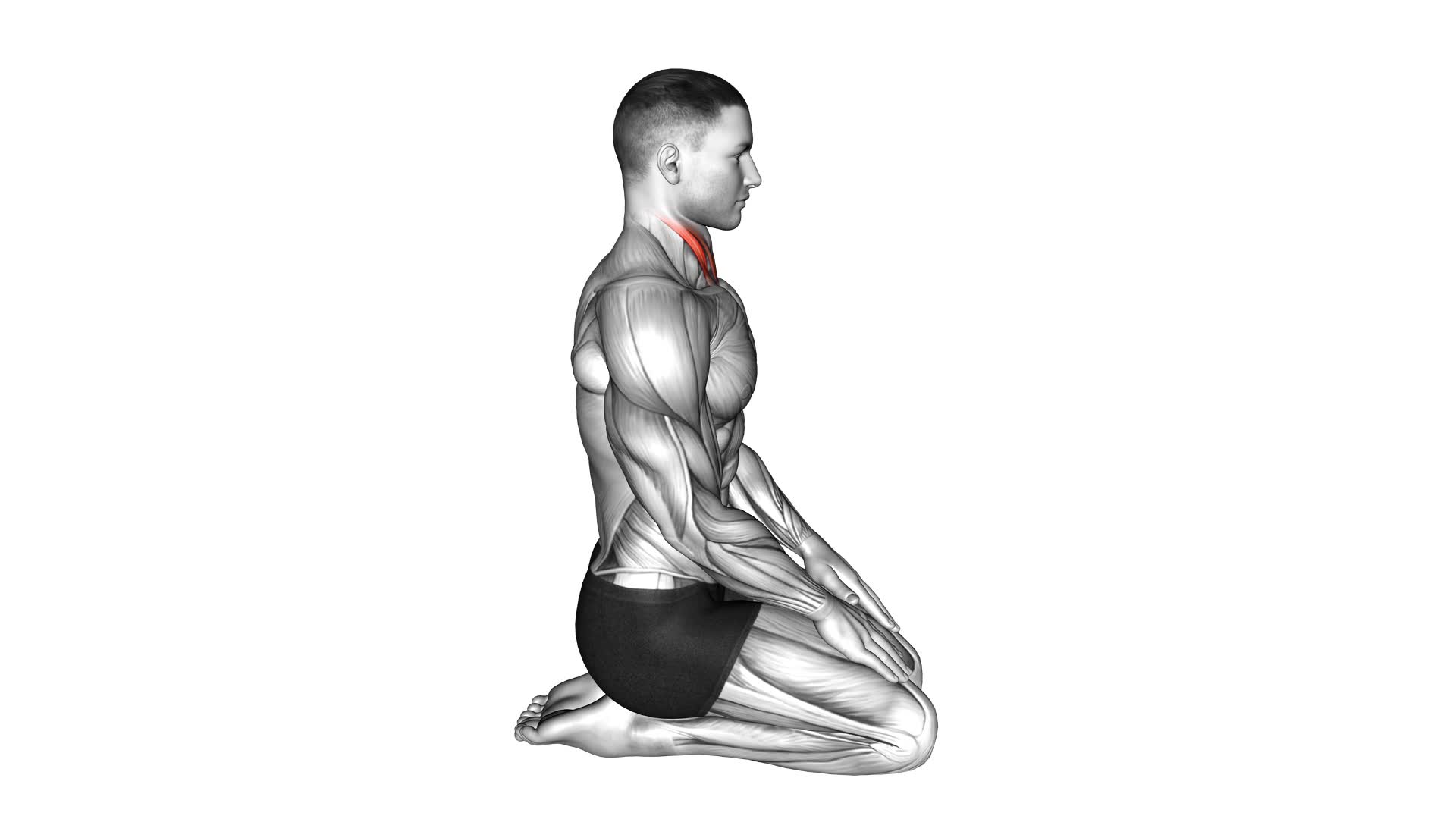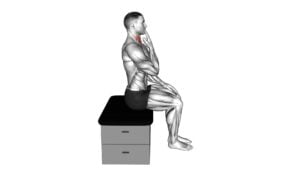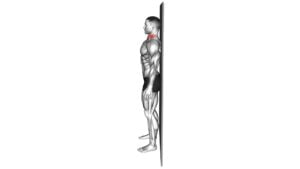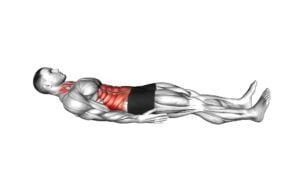Seated Chin Tuck – Video Exercise Guide & Tips

Are you looking for an effective exercise to improve your posture and strengthen your neck muscles? Look no further than the Seated Chin Tuck!
Watch This Exercise Video
In this video exercise guide, we'll show you the proper form and technique to perform this exercise correctly. You'll also learn about common mistakes to avoid and discover progressions and modifications to challenge yourself.
Incorporate the Seated Chin Tuck into your routine for better posture and a stronger neck.
Let's get started!
Key Takeaways
- Seated Chin Tuck improves posture and alleviates neck and shoulder tension.
- There are variations and modifications of the exercise to target specific areas of the neck and increase muscle activation.
- Proper form and technique include sitting upright, tucking the chin inwards, and engaging core muscles.
- Common mistakes to avoid include improper alignment, holding breath, rushing through the exercise, and failing to maintain proper form.
Benefits of the Seated Chin Tuck
One of the key benefits of the Seated Chin Tuck is that it helps improve your posture and alleviate neck and shoulder tension. Maintaining correct form during this exercise is crucial to maximize its benefits. By sitting upright with your back against a chair, you create a stable base for the exercise.
Start by gently tucking your chin towards your chest, as if you're creating a double chin. Keep your eyes looking straight ahead and avoid tilting your head up or down. This position helps to align your spine and activate the muscles in the front of your neck.
Performing the Seated Chin Tuck regularly can contribute to better posture by strengthening the deep muscles in your neck and upper back. These muscles play a vital role in supporting your head and maintaining proper alignment. Additionally, this exercise can alleviate tension in the neck and shoulder area, which is often caused by poor posture and prolonged sitting.
There are variations of the Seated Chin Tuck that you can incorporate into your routine to target specific areas. For example, you can place your hands on the back of your head and gently press to create resistance as you perform the chin tuck. This variation adds an extra challenge and increases the activation of the muscles in the back of your neck.
Remember to start with the basic form and gradually progress to more advanced variations as your strength and flexibility improve.
Proper Form and Technique
To ensure proper form and technique during the Seated Chin Tuck exercise, focus on maintaining a neutral spine and avoiding any tilting of the head. This exercise is beneficial for strengthening the neck muscles and improving posture.
Here are some key points to keep in mind:
- Start by sitting upright with your feet flat on the floor and your shoulders relaxed.
- Gently tuck your chin inwards towards your throat, as if creating a double chin. Be careful not to tilt your head backward or forward.
- Keep your gaze straight ahead, with your eyes looking forward and slightly downward.
- Engage your core muscles to support your spine throughout the exercise.
- Breathe deeply and relax your shoulders as you hold the chin tuck position for a few seconds.
- Repeat the exercise for several repetitions, gradually increasing the duration of each hold.
Maintaining proper form and technique is crucial to maximize the benefits of the Seated Chin Tuck exercise and avoid potential injuries. By focusing on a neutral spine and avoiding head tilting, you can effectively target the neck muscles and improve your overall posture.
Now, let's move on to the next section and discuss common mistakes to avoid.
Common Mistakes to Avoid
To avoid common mistakes during the Seated Chin Tuck exercise, you should frequently check your form and technique. Proper technique is crucial to ensure that you get the maximum benefit from this exercise.
One common mistake to avoid is allowing your head to tilt too far back. This not only reduces the effectiveness of the exercise but also puts unnecessary strain on your neck.
Another mistake is failing to maintain proper alignment of your spine and shoulders. It's important to keep your back straight and your shoulders relaxed throughout the exercise.
Additionally, be mindful of your breathing. Holding your breath or taking shallow breaths can cause tension in your neck and shoulders. Remember to inhale deeply and exhale slowly as you perform the chin tuck.
Finally, rushing through the exercise is another common mistake. Take your time and perform each movement slowly and deliberately to ensure proper form.
Progressions and Modifications
To enhance the effectiveness of the Seated Chin Tuck exercise, try incorporating various progressions and modifications into your routine. Progressions and modifications can help you challenge different muscle groups, increase intensity, and avoid plateauing in your fitness journey.
Here are three options to consider:
- Resistance Band: Attach a resistance band to a sturdy anchor point behind you, such as a door handle or a pole. Holding the band with both hands, perform the Seated Chin Tuck exercise while pulling against the resistance of the band. This will engage your muscles even more, making the exercise more challenging.
- Swiss Ball: Sit on a Swiss ball instead of a chair while performing the Seated Chin Tuck exercise. The instability of the ball will engage your core muscles, forcing them to work harder to maintain balance. This modification adds an extra level of difficulty to the exercise.
- Weighted Vest: Wear a weighted vest during the Seated Chin Tuck exercise to increase resistance. The additional weight will make your muscles work harder, helping to build strength and endurance over time.
Incorporating these progressions and modifications into your Seated Chin Tuck routine will keep your workouts fresh and challenging. Remember to always listen to your body and adjust the intensity as needed.
Tips for Incorporating the Seated Chin Tuck Into Your Routine
To effectively incorporate the seated chin tuck into your routine, it's crucial to focus on proper form techniques. Keep your spine aligned and engage your core muscles throughout the exercise.
Additionally, be aware of the benefits of the chin tuck, such as improving posture, reducing neck pain, and strengthening the muscles of the neck and upper back.
Proper Form Techniques
How can you effectively incorporate the Seated Chin Tuck into your routine? To ensure proper form and maximize the benefits of this exercise, follow these tips:
- Sit up straight with proper posture, aligning your ears, shoulders, and hips.
- Place your fingertips on your chin to guide the movement.
- Slowly and gently retract your chin, pulling it back towards your neck, while keeping your head level.
Maintaining proper form during the Seated Chin Tuck is crucial for achieving the desired results. By practicing good posture and engaging the correct muscles, you can effectively relieve neck pain and improve your overall posture.
Now, let's explore the numerous benefits that the Chin Tuck exercise offers.
Benefits of Chin Tuck
To effectively incorporate the Seated Chin Tuck into your routine and reap its benefits, it's important to understand the numerous advantages of this exercise and how it can improve your overall posture and alleviate neck pain.
The Seated Chin Tuck primarily focuses on neck posture improvement and neck pain relief. By performing this exercise regularly, you can strengthen the muscles in your neck and upper back, which helps to correct forward head posture and reduce strain on the neck. This, in turn, can alleviate neck pain and discomfort caused by poor posture or prolonged sitting.
Additionally, the Seated Chin Tuck helps to improve the alignment of your spine, promoting better overall posture and reducing the risk of developing chronic neck issues.
Now that you understand the benefits of the Seated Chin Tuck, let's delve into some final thoughts and additional resources to enhance your exercise routine.
Final Thoughts and Additional Resources
Now that you understand the benefits of the Chin Tuck exercise, it's important to focus on proper form and technique to maximize its effectiveness.
Make sure to maintain a neutral spine and engage your deep neck flexors when performing the exercise.
Additionally, incorporating recommended exercises and stretches into your routine can further enhance the benefits of the Seated Chin Tuck.
Benefits of Chin Tuck
One benefit of the Chin Tuck exercise is that it can help improve your posture and reduce neck pain. By performing this exercise regularly, you can strengthen the muscles in your neck and upper back, which play a crucial role in maintaining proper posture. This can prevent slouching and rounded shoulders, promoting a more aligned and upright position.
Additionally, the Chin Tuck exercise targets the deep neck flexor muscles, which are often weak and can contribute to neck pain. Strengthening these muscles can alleviate discomfort and tension in the neck region.
Other benefits of the Chin Tuck exercise include improved head alignment and increased range of motion in the neck. By incorporating this exercise into your routine, you can experience the positive effects of better posture and reduced neck pain.
Now, let's move on to discussing the proper form and technique for performing the Chin Tuck exercise.
Proper Form and Technique
To ensure proper form and technique for the Seated Chin Tuck exercise, follow these guidelines.
Start by sitting up straight in a chair with your feet flat on the ground. Place your hands on your thighs, palms facing down.
Begin by gently tucking your chin towards your chest, keeping your neck and back straight. Avoid tilting your head or rounding your shoulders. Hold this position for a few seconds, then slowly return to the starting position.
Repeat for the desired number of repetitions.
It's important to note some common mistakes to avoid. These include hunching your shoulders, forcing the chin tuck, or straining your neck.
As you progress, you can increase the duration of the hold or add resistance by placing your hands against your forehead.
If you need modifications, you can perform the exercise while lying down or against a wall.
Now that you have learned the proper form and technique for the Seated Chin Tuck exercise, let's move on to recommended exercises and stretches.
Recommended Exercises and Stretches
To continue the discussion on recommended exercises and stretches, let's explore some effective options to complement the Seated Chin Tuck exercise.
Incorporating these exercises and stretches into your routine can help improve posture and strengthen the muscles in your neck and upper back. Here are three options to consider:
- Neck Retraction: Start by sitting or standing with your spine straight. Slowly bring your head back, keeping your chin level. Hold for a few seconds and then return to the starting position. Repeat this movement several times.
- Upper Trapezius Stretch: Sit or stand with your shoulders relaxed. Tilt your head to one side, bringing your ear towards your shoulder. Hold for 15-30 seconds and then switch sides. You should feel a gentle stretch along the side of your neck.
- Shoulder Blade Squeeze: Sit or stand with your arms by your sides. Squeeze your shoulder blades together, imagining that you're trying to hold a pencil between them. Hold for a few seconds and then release. Repeat this movement several times.
Incorporating these exercises and stretches into your routine can help improve posture, reduce muscle tension, and promote overall neck and upper back health.
Remember to start slowly and listen to your body, stopping if you experience any pain or discomfort.
Frequently Asked Questions
What Is the Purpose of the Seated Chin Tuck Exercise?
The purpose of the seated chin tuck exercise is to improve your posture and strengthen the muscles in your neck and upper back. By bringing your chin towards your chest while keeping your spine straight, you engage the deep neck flexor muscles and stretch the muscles in the back of your neck.
This exercise can help alleviate neck pain, improve neck and upper back mobility, and promote better alignment of the cervical spine.
Can the Seated Chin Tuck Exercise Help With Neck Pain or Posture Issues?
The seated chin tuck exercise is an effective way to address neck pain and improve your posture. By performing this exercise, you can experience relief from neck pain and tension.
Additionally, the seated chin tuck exercise helps to correct poor posture, which can contribute to neck pain and discomfort. By regularly incorporating this exercise into your routine, you can promote proper alignment of the spine and strengthen the muscles that support your neck and upper back.
How Often Should I Perform the Seated Chin Tuck Exercise for Best Results?
For best results, it's important to consider the frequency at which you perform the seated chin tuck exercise. By incorporating this exercise into your routine on a regular basis, you can improve your posture and alleviate neck pain.
It's recommended to perform the seated chin tuck exercise at least three times a week. Additionally, varying the seated chin tuck variations can help target different muscle groups and enhance the effectiveness of the exercise.
Are There Any Precautions or Contraindications for Performing the Seated Chin Tuck Exercise?
Precautions and contraindications should always be considered before performing the seated chin tuck exercise. It's crucial to consult with a healthcare professional if you have any neck or spine injuries, as this exercise may exacerbate the condition.
Additionally, individuals with severe osteoporosis or cervical spine instability should avoid this exercise altogether.
It's important to prioritize safety and seek professional guidance to ensure the exercise is suitable for your specific circumstances.
Can the Seated Chin Tuck Exercise Be Done by Individuals With Limited Mobility or Injuries?
Yes, the seated chin tuck exercise can be performed by individuals with limited mobility or injuries. This exercise specifically targets the muscles in the neck and upper back, helping to improve posture and reduce neck pain.
If you have limited mobility or injuries, it's important to start with a small range of motion and gradually increase as tolerated. Always listen to your body and consult with a healthcare professional before starting any exercise program.
Conclusion
In conclusion, the seated chin tuck exercise is a beneficial movement for improving posture and strengthening the neck muscles. By maintaining proper form and avoiding common mistakes, you can maximize the effectiveness of this exercise.
Progressions and modifications can be made to suit your fitness level, and incorporating the seated chin tuck into your routine is a great way to improve overall posture and reduce neck pain.
Follow the provided tips and resources to get the most out of this exercise.

Author
Years ago, the spark of my life’s passion ignited in my mind the moment I stepped into the local gym for the first time. The inaugural bead of perspiration, the initial endeavor, the very first surge of endorphins, and a sense of pride that washed over me post-workout marked the beginning of my deep-seated interest in strength sports, fitness, and sports nutrition. This very curiosity blossomed rapidly into a profound fascination, propelling me to earn a Master’s degree in Physical Education from the Academy of Physical Education in Krakow, followed by a Sports Manager diploma from the Jagiellonian University. My journey of growth led me to gain more specialized qualifications, such as being a certified personal trainer with a focus on sports dietetics, a lifeguard, and an instructor for wellness and corrective gymnastics. Theoretical knowledge paired seamlessly with practical experience, reinforcing my belief that the transformation of individuals under my guidance was also a reflection of my personal growth. This belief holds true even today. Each day, I strive to push the boundaries and explore new realms. These realms gently elevate me to greater heights. The unique combination of passion for my field and the continuous quest for growth fuels my drive to break new ground.







